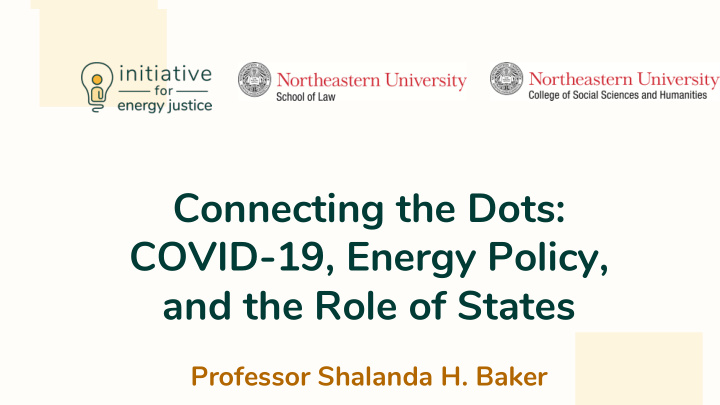



Connecting the Dots: Connecting the Dots: Black Lives Matter, Connecting the Dots: COVID-19, Energy Policy, COVID-19, and COVID-19, Energy Policy, Energy Policy and the Role of States and the Role of States Professor Shalanda H. Baker Professor Shalanda H. Baker Professor Shalanda H. Baker
Initiative for Energy Justice (iejusa.org)
Overview • What is this moment? • COVID-19 and Environmental Justice • COVID-19 and Energy Access • Energy Justice and the Role of States
4 Photo: Andrew Burton/Getty Images
COVID-19 and Environmental Justice Wu et al. (2020).
COVID-19 in Greater Boston Area
NATA Respiratory Hazard Index
Image: MedPage Today Image: Environmental Integrity Project
A missed opportunity for economic justice: “We don’t own anything!”
Energy Burden and Energy Insecurity Energy Burden: Percentage of household income that goes toward energy costs. The lower your income, the more you spend on energy. Energy Insecurity: Lacking reliable access to uninterrupted energy sources at an affordable price. https://www.aceee.org/press/2016/04/report-energy-burden-low-income https://www.iea.org/topics/energy-security
Shares of Households by Race Experiencing Energy Insecurity, 2015 Hispanic or Latino 45.0% White Non-Hispanic or Latino 25.4% Black or African American 52.2% Asian 20.4% American Indian or Alaska Native 61.5% Native Hawaiian or other Pacific 50.0% Islander 0 10 20 30 40 50 60 70 Percentage of Households https://ips-dc.org/report-energy-efficiency-with-justice/
Energy Burden Energy burdens (at the county level) for LMI households. The lightest color reflects <6% of annual income spent on housing energy bills, and the darkest is >19%. Source: Union of Concerned Scientists
COVID-19 and Utility Shut-offs Analysis: Center for Biological Diversity
COVID-19 Exposes Twin Burdens • Environmental burdens borne by BIPOC communities • Economic burdens borne by BIPOC communities • Shut-offs to commence July 17th
Energy Justice: An Opportunity for States
An Energy Justice Approach to Energy Policy in this Moment • Recognize prior harms. • Include the voices of frontline communities in energy policymaking. • Adopt solar policies and incentives that center BIPOC communities. • Reduce energy burden.
HEALING HOPE TRANSFORMATION LOVE S.H. Baker, Revolutionary Power: An Activist’s Guide to the Energy Transition (Island Press) (January 2021).
Thank you. 25
Extra Slides
What is Energy justice refers to the goal of achieving equity in both the social energy justice? and economic participation in the energy system, while also remediating social, economic, and health burdens on those historically harmed by the energy system (“frontline communities”). Energy justice explicitly centers the concerns of marginalized communities and aims to make energy more accessible, affordable, clean, and democratically managed for all communities.
Heffron & McCauley (2017).
What is energy justice?
What is energy justice?
Recommend
More recommend